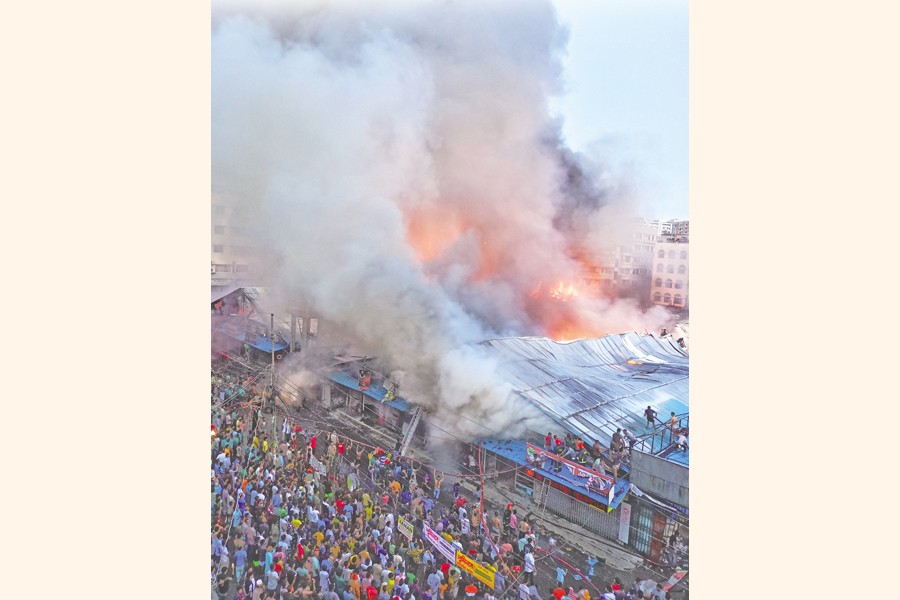
A devastating fire at Krishi Market, Mohammadpur has reduced 217 out of 317 shops to ashes. This is, however, official estimate of the registered shops. The unofficial count puts the total number of shops to more than 500 and of which 400 have either been fully gutted or partially damaged. Why the numbers of shops are at variance goes to the credit of different quarters reaping unearned benefits. It is quite a sprawling market with three large sheds providing special areas and corners designated for groceries, stem and root tubers such as potato, onion, garlic and zinger. Similarly, there is a rice-only section, another section for puffed, beaten rice, peanut, almond, coconut, molasses and of course a row for only betel leaf and betel nut.
However, this middle shed also has a corner to the north-east where there are a few permanent vegetable shops. But the market's strong point is its floating vegetable vendors who temporally station themselves on roadsides in the open. Then the shed's accommodation gets completed by the long row of shops known as 'tong ghar' on raised platforms compartmentalised in the barest minimum space open to the west but with no provision for doors. More than half of this row has shops of readymade garments and the rest of the row has shops of wrist watches, batteries, toys etc.
This is the shed where the fire originated. It spread to the shed on the western side where jewelleries, shops of all kinds of clothes including sharis, lungis and gamchas or local towels, cosmetics, hardware and crockery, clocks and watches are housed. The shed on the eastern side designated for fish, red meat, chicken and eggs remained completely unaffected. The space on either side of the middle shed to each is equal. So if fire spread to the western shed, why did the eastern shed remain untouched? The answer is simple. On the night, the breeze stronger than moderate was blowing from the southeast. Thus the flames were carried to the western shed and the eastern shed was unaffected. Even if flames could reach the eastern shed, they had few things, excepts the baskets used for carrying fish, to burn.
Now the question that comes to the fore is which market of the capital is next to suffer this tragic fate? Whether it's kitchen market or garment market like Bangabazar, involved here are the investments of small to lower-middle traders. If their capital thus goes into smoke, what happens to their families defies description. It is not only them, there are a number of employees with each of these outlets. The number of dependants thus affected comes to several thousands when a market is burnt down.
After each such tragic fire incident, the different agencies concerned engage in a blame game. Intriguingly, this market was not in the list of the those at risk of fire. But now the association of the shop owners are accused of not making any arrangement for fire safety.
A few things need to be made clear here. If a market designed to have collapsible gates at the entry points and the night guards are stationed outside, what's the use of fire safety system unless the guards have access to main areas and are trained to handle fire extinguishers and other equipment? The responsibility ought to be on the city corporations to install such mechanism of fire safety that is easy to operate.
After the April Bangabazar and New Market devastation, this one makes the third such case where the fire breaks out in the small hours. Is this a mystery or a coincidence? There must be a plausible answer to this question. Even if short-circuit is to blame in all three cases, why should it have to take place only in the wee hours before the dawn? Burnt mosquito coils or cigarette tips can be a source of the fire. But in case of Krishi Market, reportedly there was none inside as it was a weekend for the market.
Now the fire brigade authorities have complained that the night guards were nowhere to be found when they looked for keys to enter the market. The fire fighters had to break open the gates before entering and operating extinguishers. This issue cannot be overlooked. Their role has to be brought under the scanner. Notably, the centrally controlled electricity of the market is switched off after 10 pm.
If the management of the market tinker with the original formation of shops and raise one and a half times or even twice the number, the facilities are sure to get congested. The area where the fire originated was in fact a passage but even it was allotted to a vendor of readymade garments. Every available space even on the open roadside is thus leased for a hefty amount apart from the daily tolls. This not only shrinks the space for customers' movement but also puts the power and other utility system under severe stress. These issues should be taken into account for making a comprehensive probe into the fire at Krishi Market. Finally, this provides a lesson for other markets and future organisation of this market as well.
© 2025 - All Rights with The Financial Express
